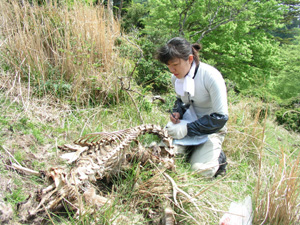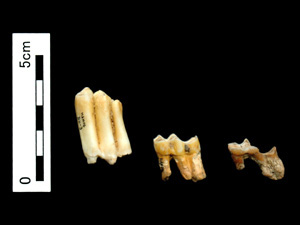




宮城県金華山島における野外調査と自然死個体の回収

回収されたニホンジカ頭骨標本

絶滅種リュウキュウジカの下顎大臼歯と磨耗
現生種間や化石記録にみられるマクロレベルの進化パターンは、現生の種内においても見られるのか、という点に関心を持ち、哺乳類を材料とした実証研究を進めてきた。草食性哺乳類において、大臼歯の歯冠が高くなる高歯冠化は現生種・絶滅種を問わず何度も生じた進化パターンであり、これは珪酸質や繊維質の多い植物を採食し、大臼歯が磨耗することに対する適応であると考えられてきた。しかしながら、その前提となる「食性などによって大臼歯の磨耗は異なる」「大臼歯の磨耗は適応度に影響を与える」という仮定はこれまで検証されてこなかった。私は生態学的データが蓄積している現生ニホンジカを対象に、集団間での形態学的比較により上記問題にアプローチしてきた。また現生種のデータを用いて、化石種の古生態・生活史復元を試みる研究や、その先史人類学的な応用にも取り組んでいる。
略暦
2003年 東京大学理学部生物学科卒業
2005年 東京大学大学院農学生命科学研究科修士課程修了
2010年 東京大学大学院理学系研究科博士課程修了 博士(理学)
2010年 東京大学総合研究博物館 特任研究員
(2011年9月〜2012年3月 出産育児の為、休職)
2013年 日本学術振興会特別研究員PD
Mugino Ozaki Kubo
I am studying evolutionary ecology of large herbivorous mammals with reference to food habits and functional morphology of teeth. From fossil records, it has been shown that herbivorous mammals acquired high-crowned (hypsodont) cheekteeth independently several times. This obvious macroevolutionary trend is considered as an adaptation to consuming abrasive and fibrous plant materials. This interpretation relies on basic, but not tested, ideas that food habits and other ecological factors influence molar wear, and that molar wear has negative effects on animal's fitness. I approach the above subjects through morphological comparisons of extant sika deer (Cervus nippon) among populations. In addition, I apply the data of extant sika deer with known ecology to fossil cervid species in order to reconstruct their paleoecology and life history.
Educations and Positions Held
2003 B.S. in Biology at The University of Tokyo
2005 M.S. in Ecosystem study at The University of Tokyo
2010 Ph.D. in Biological science at The University of Tokyo
2010 Project Researcher, The University Museum, The University of Tokyo
(Maternal leave for 7 months, September 2011 - March 2012)
2013 JSPS Reserch Fellow
Publications
Kubo, T. and Kubo, M. O. Dental microwear of a Late Triassic dinosauriform, Silesaurus opolensis. Acta Palaeontologica Polonica (in press).
Kubo, M. O. and Yamada, E. (2014) The inter-relationship between dietary and environmental properties and tooth wear: comparisons of mesowear, molar wear rate, and hypsodonty index of extant sika deer populations. PLOS ONE 9:e90745.
Kubo, M. O., Minami, M., Higuchi, N., Ohnishi, N., Okada, A., Kaji, K., Ohba, T., Hosoi, E., Koizumi, T. and Takatsuki, S. (2013) Female sika deer have evolved larger incisors than males under relaxed selection against rapid tooth wear. Biological Journal of the Linnean Society 110: 384-397.
Kubo, T. and Kubo, M. O. (2013) Analysis of Triassic Archosauriform trackways: difference in stride/foot ratio between Dinosauromorphs and other Archosauriforms. Palaios 28: 259-265.
Kubo, T. and Kubo, M. O. (2012) Associated evolution of bipedality and cursoriality among Triassic archosaurs: a phylogenetically controlled evaluation. Paleobiology 38: 474-485.
Kubo, M. O., Kaji, K., Ohba, T., Hosoi, E., Koizumi, T. and Takatsuki, S. (2011) Compensatory response of molar eruption for environment-mediated tooth wear in sika deer. Journal of Mammalogy 92: 1407-1417.
Kubo, M. O., Fujita, M., Matsu'ura, S., Kondo, M. and Suwa, G. (2011) Mortality profiles of Late Pleistocene deer remains of Okinawa Island; evidence from the Hananda-Gama Cave and Yamashita-cho Cave I sites. Anthropological Science 119: 183-201.
Ozaki, M., Kaji, K., Matsuda, N., Ochiai, K., Asada, M., Ohba, T., Hosoi, E., Tado, H., Koizumi, T., Suwa, G. and Takatsuki, S. (2010) The relationship between food habits, molar wear and life expectancy in wild sika deer populations. Journal of Zoology (London) 280: 202-212.
Kubo, T. and Ozaki, M. (2009) Does pace angulation correlate with limb posture? Palaeogeography, Palaeoclimotology, Palaeoecology 275: 54-58.
Ozaki, M., Suwa, G, Kaji, K., Ohba, T., Hosoi, E., Koizumi, T. and Takatsuki, S. (2007) Correlations between feeding type and mandibular morphology in the sika deer. Journal of Zoology (London) 272: 244-257.